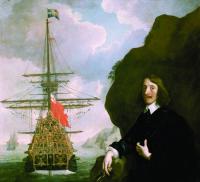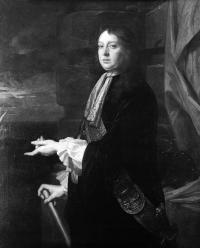‘Pirates in our channel’ the Cromwellian navy in Ireland, 1649–53
Published in 1641 Rebellion, Confederate War and Cromwell, Cromwell, Early Modern History (1500–1700), Features, Issue 4 (July/August 2011), Volume 19
Peter Pett and the Sovereign of the Seas. The Sovereign was built in Woolwich in 1637 by shipbuilder Pett, the largest of several ships commissioned by King Charles I. Ironically, when civil war broke out in 1642 the bulk of this expanded navy joined the parliamentary cause. (National Maritime Museum, London)

Captain William Penn, the parliamentary vice-admiral in Ireland, took the war directly to the enemy by launching raids on royalist-held territory from his ships. (National Maritime Museum, London)
Logistical support
In order to subdue Ireland, the parliamentary army needed to be resupplied from England. Without a continuous flow of recruits, provisions, money, clothes and munitions the army would quickly disintegrate. Disease and campaigning quickly reduced the strength of regiments sent to Ireland. To counter this, the army needed regular shipments of replacements. Throughout the period from 1649 to 1653 large numbers of soldiers were shipped to Ireland. Between March and June 1651, for example, one English newsbook, A Perfect Diurnall of Some Passages and Proceedings, included details of over 9,000 men who sailed from various ports to join the army in Ireland. Transporting these men and supplies required a huge logistical effort. The navy pressed large numbers of privately owned merchantmen and colliers into service to carry reinforcements and other military necessities to Ireland. Most of the ships that transported soldiers across were quite small. Two vessels, the Patience of Minehead (60 tons) and the Sarah of Minehead (15 tons), carried 230 infantry between them to Waterford in 1651.
The voyage to Ireland could be extremely hazardous. Shipwrecks occurred when vessels sailed in stormy weather or with crews unfamiliar with the Irish coast. In February 1650 five ships carrying over 200 soldiers sank between Kinsale and Dungarvan during a storm. The presence of privateers in the seas around Ireland also made the crossing perilous. The fall of Wexford did not signal the end of privateering in Ireland. Some captains moved to other Irish ports, such as Waterford or Galway, although the outbreak of plague in the latter in late 1649 made Galway unattractive as a base for many seamen. Other privateers moved their operations to other royalist strongholds, including the Isle of Man, the Scilly Islands and the Channel Islands. From these bases they continued to prey on shipping on the Irish seaboard. Despite the best efforts of the navy, privateers continued to seize ships en route to Ireland. In September 1652 complainants wrote that the main trade route between Dublin and Chester and Holyhead was ‘much infested with pyrates, that chase and take our little vessels’.
To prevent the loss of shipping carrying vital supplies, the navy implemented a convoy system on the Irish coast. From 1649 to 1653 the admiralty stationed men-of-war at major harbours to escort vessels going to and from Ireland. In February 1650 the Satisfaction escorted eight ships from Milford Haven to Ireland. In December 1652 the Truelove escorted shipping to the north of Ireland. Some English captains received instructions to ply the main shipping lanes between Ireland and England to keep them clear of privateers. As well as protecting merchant vessels, warships sometimes carried money, munitions or soldiers, especially senior officers and their families, across the Irish Sea. In March 1651 Captain Wood in the Guinea transported Major General Ludlow and in the same month the President carried Lady Ireton, the wife of General Henry Ireton, to Ireland. Privateering frigates in search of easy prey rarely risked engaging English men-of-war or convoys protected by them. Some privateers moved away from the seas around Ireland to seek prizes as far away as the Canary Islands and the Mediterranean. Others continued to target vulnerable ships travelling unescorted, such as the ‘pickeroon’ who seized a packet vessel carrying letters from Waterford to England in June 1651. The activities of the navy in patrolling the waters around Ireland and providing convoys meant that the army lost very few supplies to enemy action at sea. This was a key element in the ability of the army to campaign successfully in Ireland each year.
Naval action
In conjunction with providing logistical support to the army, the navy directly participated in the land campaign as the army moved along the coast or navigable rivers. Cromwell chose to move his army along the east coast in the autumn of 1649 to take advantage of this. The fleet transported his heavy artillery and provisions by sea to the sieges of Drogheda and Wexford. Men-of-war occasionally took part in attacks on royalist-held towns and fortifications. In September 1649 Captain Nathaniel Ferns sailed the President into Carlingford harbour to bombard the defenders from the sea as Colonel Venables attacked from the land side. In an exchange of fire with a blockhouse the President sustained damage to its mast but succeeded in helping to force the garrison to surrender. Similarly, at Wexford in October 1649 a parliamentary man-of-war assisted in the seizure of Rosslare fort, which guarded the entrance to Wexford harbour. The defenders tried to flee into a nearby frigate as soldiers led by Colonel Michael Jones advanced on the fort. One of the English fleet waiting outside the harbour came up to the fort and fired on the frigate, forcing it and the soldiers on board to surrender. Other officers, like Captain William Penn, the parliamentary vice-admiral in Ireland, took the war directly to the enemy by launching raids on royalist-held territory from his ships. In the summer of 1650 Penn’s flotilla anchored in the Shannon and sent parties ashore to seize livestock and burn Irish villages.

The duke of Lorraine—arms and munitions that he sent from France to the defenders of Galway had to be landed at Inishbofin, as the parliamentary ships lying in the bay made it too risky to land them directly.
Galway, with its wide, open bay, could not be closed off from external assistance as easily as Waterford and Limerick. Nevertheless, ships trying to get into the city had to pass through parliament-controlled waters for much of their voyage. As the Cromwellian army besieged Galway city in 1651 and 1652, men-of-war patrolled the west coast from Cape Clear to Galway Bay and seized numerous ships trying to get through. In February 1652 Captain Robert Clarke in the Reserve took a vessel carrying 200 tons of wheat and rye for Galway. A report gleefully noted that the loss ‘will cause them shortly to eate their butter without bread’. The navy also succeeded in preventing foreign military assistance from making a significant contribution in Ireland. Arms and munitions sent from France by the duke of Lorraine to the defenders of Galway had to be landed at Inishbofin, as the parliamentary ships lying in the bay made it too risky to try and get them ashore there. The surrender of Galway in April 1652 effectively marked the end of the naval conflict on the Irish coast. Inishbofin, the last significant royalist maritime outpost in Ireland, was not taken until February 1653. By that time the navy had bigger concerns than the capture of an isolated island off the west coast of Ireland, as war broke out with the Dutch in 1652.
Conclusion
The navy played a pivotal role in the Cromwellian conquest of Ireland. By keeping the sea lanes open and blockading the main royalist-held ports the parliamentary navy gained control of the seas around Ireland. This dominance enabled the government in London to reinforce and resupply their armies in Ireland. This in turn allowed military commanders to press on with the campaign on land. HI
Elaine Murphy is an IRCHSS postdoctoral fellow in the Department of History, Trinity College Dublin.
Further reading:
B. Capp, Cromwell’s navy: the fleet and the English Revolution, 1648–1660 (Oxford, 1989).
M. Ó Siochrú, God’s Executioner: Oliver Cromwell and the conquest of Ireland (London, 2008).
J. Scott Wheeler, Cromwell in Ireland (Dublin, 1999).
















